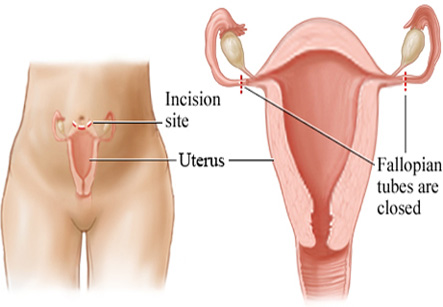Tubal Surgery
Introduction
Tubal problems are found in at least 15% of infertile couples. The past medical history may reveal the possibility of damaged fallopian tubes, as in following cases:
• previous terminations of pregnancy with the same fertile partner
• past pelvic inflammatory disease
• appendicitis with peritonitis
• major pelvic surgery
50 % of the women who are subsequently found to have blocked tubes have no significant past medical history that might indicate that there can be a problem

Infection of the tubes may occur after a completely normal pregnancy or may complicate a miscarriage. It can also make the insertion of an intra-uterine contraceptive device difficult; but it is complex to be sure whether the infection is related to the insertion of the device or whether it pre-existed the insertion and was stirred up by the device.
Surgery is followed by adhesions. The outer covering layer of the abdominal and pelvic organs is very delicate. Presence of blood causes inflammation of this delicate tissue during surgery, which is often difficult to avoid, the use of surgical gauze packs to hold back the large bowel to get better exposure at the site of the surgery, and even just the handling of the tissues being operated upon.
50 % of the women who are subsequently found to have blocked tubes have no significant past medical history that might indicate that there can be a problem. On the contrary, there can be a history highly suggestive of tubal disease and the tubes are found to be healthy. Tubal patency testing confirms the tubal damage. An X-ray called hysterosalpingogram X-ray (HSG) can show obstructed tubes or tubes that appear to be open but tied by adhesions. Laparoscopy and dye insufflations are generally accepted as being the “gold standard diagnostic therapies” for assessing the status of the tubes as it gives the IVF specialist a direct view of the pelvic organs.
If a woman’s tubes are blocked, she has become sterilized. Such a patient may undergo a tubal surgery or an IVF treatment. Patient’s chances of becoming pregnant without any treatment are zero. The IVF specialist may study the prospects of a successful outcome from the information obtained by patient’s laparoscopy.
The extend of the tubal damage decides the degree of success from surgery
• The chances of the surgery being highly successful if there are only a few cellophane-like adhesions deforming the tubes or separating the tubes from the ovaries. This is because the tubes and ovaries beneath the adhesions are often completely healthy and normal. The division of adhesions around the tubes (an operation called salpingolysis) and from the ovaries (called as oophorolysis) can have a striking effect on fertility.
• If the ovaries are enclosed in a thin bag of adhesions, releasing the ovaries and giving the eggs access to the tubes may be all that is required to restore fertility to normal. This type of surgery can usually be carried out at laparoscopy as a day case.
• In some cases, the adhesion tissue is very dense and almost like plastic. In this situation the prospects of pregnancy resulting from surgery are remote.
• If the tubes are blocked at their outer ends, when dye is instilled at HSG or laparoscopy, the tubes become distended. Rarely the pressure of instilling the dye forces some dye through the sealed off end of the tube, but this invariably seals off again. If there is no gross distension or distortion of the tubes, an operation (salpingostomy) can be performed to open the blocked ends, rather like the opening of a flower. To try and deject the tubes from closing up again, very fine stitches can be placed so that the edges of the open tubes are slightly turned outwards rather like the lip of a vase. Some specialists will carry out salpingostomy operations by laparoscopy, while others may prefer to perform the tubal surgery as an open abdominal operation through a low “bikini” incision. Overall success rates of 30% are possible.
• If the hydrosalpinx is grossly distended, the patient would be unlikely to benefit from salpingostomy. In all probability the original inflammation process that caused the obstruction will have destroyed the delicate and complex lining of the tubes. If patient is going to have IVF as an alternative, a good case can be made for either removing a grossly distended hydrosaloinx (salpingectomy) or placing a clip on the tube at its junction with the uterus. The reason for this is that there is evidence that the fluid within the tubes can interfere with the successful implantation of a pregnancy by IVF. These procedures are usually performed at a laparoscopy.